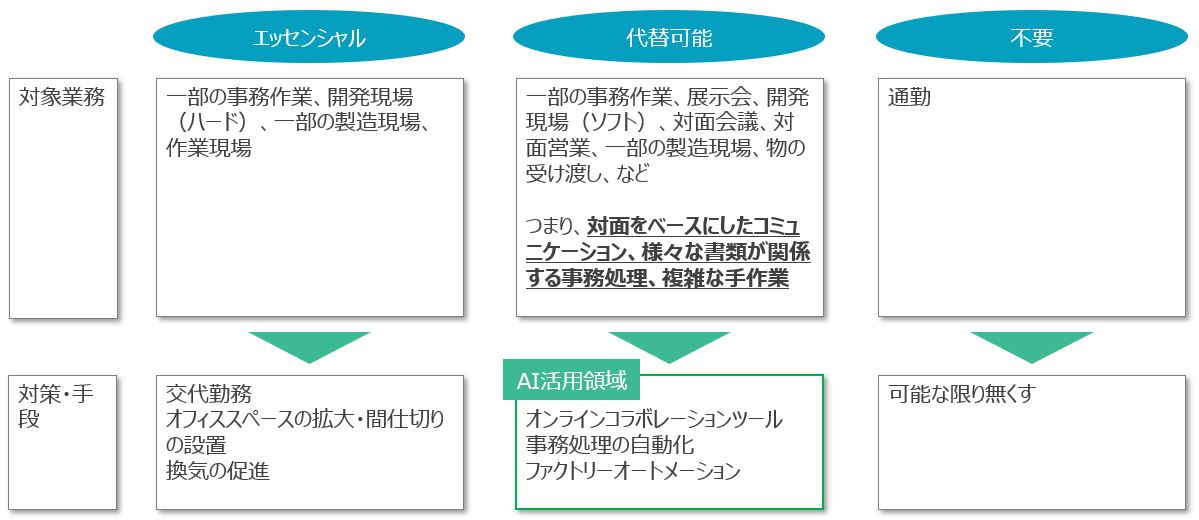
blog cinnamon blog

- management
<第2回>With the changing work style and AI utilization in the corona era
How can we use AI to dramatically change the way we work in the Corona era?

1stNow, we have explained the four points of change and the perspective of separating work, using the keywords "Three Cs and the movement of people."
This time, I would like to use manufacturing companies as an example to consider what changes will occur and what kind of AI will be increasingly used there.
Manufacturing industry that is often closed and crowded
To simplify the discussion, let's assume that the main operations of a mid-sized to large manufacturing company are sales activities, office operations, factories, and distribution centers.
Let's make a list of the four areas of work that are affected by the ``Three Cs'' and the reduction in people's movement.
| 1. Sealed | 2. Crowded | 3. Close | 4. Movement of people | |
| work activities | Office environment for office work exhibition Work site visit | Office environment for office work exhibition | Face-to-face sales | Customer/site visit |
| office work | do office work office environment | do office work office environment | face-to-face meeting | commute |
| production activities | Development site (software/hardware) Manufacturing premise | Development site (software/hardware) Manufacturing premise | face-to-face meeting delivery of goods | commute |
| Logistics operations | work site | work site | face-to-face meeting Freight collection and delivery | commute |
Of course, I haven't been able to list all the tasks, but I hope you can get an idea of how to list them.
Major changes will occur in ``face-to-face communication,'' ``administrative processing involving various documents,'' and ``complex manual work.''
Now, let's break it down into ``essential, substitutable, and unnecessary.''

Essential work cannot be completely eliminated, so it is important to reduce the workload and risk of infection. For example, if you have not introduced shift work, you could consider introducing it. With the coronavirus era, it is necessary to maintain social distancing, but doubling the area of offices and factories is not easy. Therefore, by working two shifts in the morning and evening, it is possible to maintain operations while maintaining the same number of staff and capacity. Of course, consent from employees is required, but if this kind of two-shift work system is realized, it will be possible to increase the utilization rate of limited machinery and hardware.
All or part of the work that can be replaced can be replaced. In many companies, most of the work falls into this area. Also, realistically, some companies may choose not to replace everything all at once, but to gradually replace them in accordance with the work environment. In this manufacturing industry case, the tasks are summarized as "face-to-face communication," "administrative processing involving various documents," and "complex manual work." IT tools that drive change include online work tools, office automation, and factory automation. How will AI be used in these areas?
Three aspects of Check Point substitutable work
・Face-to-face communication
・Administrative processing involving various documents
・Complicated manual work
Three areas where AI utilization is dramatically advancing in the era of coronavirus
I believe that the need for AI utilization will inevitably increase for online work tools, office processing automation, and factory automation.
| region | Expected usage methods and future outlook |
| online work tools | The use of AI will be promoted from an HR perspective, such as improving motivation and engagement, and improving productivity by promoting collaboration. |
| Automation of paperwork | As technology becomes more sophisticated, the number of applicable areas continues to increase. |
| factory automation | The needs are increasing, but the investment amount will also be large, so it is necessary to assess the return on investment. |
Online collaboration tools include online communication tools such as chat and online meetings, and document/workflow management systems that digitize document management and workflow. In recent years, various online collaboration tools have been created by major companies and startups, and I'm sure many of you are already using some kind of tool. For example, from an HR perspective, these online collaboration tools use natural language analysis and image analysis to analyze messages exchanged on online communication tools and video of online meetings to improve employee motivation. It is thought that progress will be made in making engagement visible.
The use of PRA and AI-OCR is progressing in the automation of office processing, and this field will continue to evolve in the future. We believe that the functions of AI that have been introduced in business situations that we interact with on a daily basis are only a small part of the possibilities that AI can realize. For example, current deep learning can be said to replace tasks that humans can handle using simple intuition or memory. In the future, with the addition of various exception handling and reasoning mechanisms, more advanced tasks will be replaced, and non-routine intellectual tasks and administrative tasks will also be increasingly replaced. For companies that have not yet introduced it, this may be an area where they can make a quick impact.
Factory automation is an area that has been receiving a lot of attention in manufacturing and logistics settings for some time. I'm sure you've all heard that Amazon is significantly automating its logistics operations through the use of robots. Of course, Amazon has not been able to automate all logistics operations at this point, but the expectations for factory automation in manufacturing and logistics sites are increasing, and the need for it is increasing even more in the With Corona era. Masu. However, since transforming production lines requires large investments, it is important to assess the return on investment.
SummaryIn existing work, find "face-to-face communication", "administrative processing involving various documents", and "complex manual work" that are affected by the four changes of "3 Cs + movement of people" This is the starting point for considering AI.
This time, we have used the manufacturing industry as an example to explain four points of change and the use of AI in anticipation of the With Corona era. We hope that this kind of perspective will serve as an opportunity to promote work style change in your business as well.
In Part 3, we will look at specific examples of changes that are actually occurring with Cinnamon AI customers.
 Cinnamon AI Director and COO Yoshiaki Ieda Joined Cinnamon after working at Dentsu, Recruit, P&G Singapore and starting a business. Based on his extensive experience in launching new businesses, he is in charge of new business consulting and product/service design. Bridging business requirements and technical solutions. Cinnamon AI Director and COO Yoshiaki Ieda Joined Cinnamon after working at Dentsu, Recruit, P&G Singapore and starting a business. Based on his extensive experience in launching new businesses, he is in charge of new business consulting and product/service design. Bridging business requirements and technical solutions. |
At Cinnamon AI, we help companies utilize AI and promote work style reform through consulting, workshops, and solutions. We would appreciate it if you could feel free to contact us.
Click here to contact us => Inquiry form
Recommended articles
-
 management
management -
 management
managementPurpose formulation and harvest loop based on customer experience
Purpose formulation and harvest loop based on customer experience
-
 management
managementThe concept of “Expert-in-the-Loop” where humans and AI work together
The concept of “Expert-in-the-Loop” where humans and AI work together
